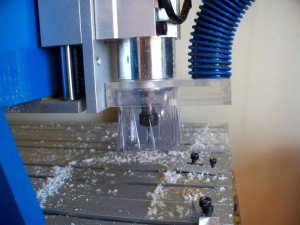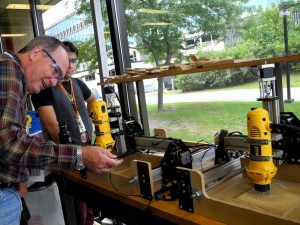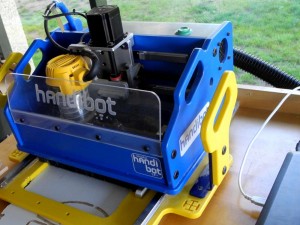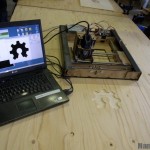Marauder CNC
The world needs more portable and accessible CNC stuff.
Makers can visit venues with various cutters (and people have their own cutters) but I think it’s time for “pop-up cnc” that can appear in guerrilla situations.
Why not a 3D printer? I think the 3d Printer thing is a bit out of proportion. They are cool but the average maker will make few parts with them (unless they are specifically designing for it). I’d like to do a little differentiation and forget the hype. These machines are already portable anyway since they’re pretty small.
Why not a laser? Lasers are totally solid. But they’re pricey/complex for an affordable DIY project. Also tend not to be portable since the cheaper tubes are water cooled. If someone could point me to a robust and inexpensive laser tube that doesn’t require water cooling that could change the game.
So I’m retrieving the old Marauder CNC project. I need to rewrite the objective slightly to have sufficient emphasis on portability (or whatever else comes forward). 🙂
What do you think?
DIY CNC Objective
- Simple-affordable machine anyone can make.
- Small enough to tote around.
- Enclosure for dust/noise control.
- Able to cut hardboard, cardboard, acrylic and other sheet.
- Fabrication from common tools.
- Inexpensive and available parts.
- The initial project had a cutting area of 12x9x1″ or 12x12x2″. I think it is worth making something that has a roller like the Phlatprinter (see below). Perhaps a 12″ width?
- Support simple spindle such as a dremel.
Why another CNC design? There are good designs out there already but they are expensive or difficult to make. Affordable ones such as Mantis have a small cutting format and the plans have gaps. Owning it is not compelling enough for the average person to go through the trouble to make it.
I know there will be the objection that it will not support real 3D. The configuration is very 2.5Dish (there’s a new word for ya). In my humble opinion 2.5D is extremely valuable since inexpensive material comes in sheets. Also the 2 or 2.5D cutting is a removal of minimal material (cutting lines) which means it’s faster. Making an object using 3D additive construction is slow (as is subtraction in the 3D space).
So I think a 2.5D specialized machine (with portability) can rock the boat.
Issues
The proposed pinch roller system has been successful on a couple of known machines (see below). But I’m a little concerned about it. I will experiment. I think there will be a sweet spot where there’s no fixturing and softer stuff like hardboard can be processed.
Another area is waste. It stresses me a bit to think about the fact that the rollers don’t let you cut to the edge of the work-piece on the Y axis. I’m mostly over that though. The waste can be processed into parts on a laser (outside the portable context).
Vertical Work-piece
I’m wondering if putting the rollers vertical so dust falls to the ground. Can you come up with a reason not to?
Spindle
 These quiet spindles look nice. I have one of those on my existing CNC and I love it. They’re pretty affordable. If you go to ebay and search “ER11 Spindle” all sorts of nice variants come forward from $50 bucks and up.
These quiet spindles look nice. I have one of those on my existing CNC and I love it. They’re pretty affordable. If you go to ebay and search “ER11 Spindle” all sorts of nice variants come forward from $50 bucks and up.
I think this is a good investment for any maker. When you think of how much stuff it can cut for you over the years, owning one of these is really a necessity. I think variable speed is very desirable. Might be fun if the machine can control the spindle too.
My concept drawing above shows a Dremel. Frankly I don’t like the idea of a dremel (as a hand held they are a dream). But for CNC they’re noisy, have bearing run-out and they’re physically long.
I happen to have an ER11 chuck lying around somewhere. I’ll look at that and see what comes forward as well.
Controller
I’ve got a couple of these outfits from ebay on hand. They’re about $150. There are cheaper ones in Nema 17 which may have been around 80 (I have some on hand as well). They work well with Mach3. This is definitely something under consideration and will likely be tried on prototypes.
 Another thing is grbl which uses the USB port and an Arduino. There are all sorts of client softwares out there such as Grbl Controller 3. This allows you to run the machine from a laptop. We had a go with this software yesterday at the Ottawa University Makerspace. Limitations I’m looking at (which may be less of a problem with other clients) are:
Another thing is grbl which uses the USB port and an Arduino. There are all sorts of client softwares out there such as Grbl Controller 3. This allows you to run the machine from a laptop. We had a go with this software yesterday at the Ottawa University Makerspace. Limitations I’m looking at (which may be less of a problem with other clients) are:
- Wasn’t clear how to zero the machine. We just manually jogged the machine with the controller off and started the job from there.
- Requesting a stop to the machine was sluggish.
- Couldn’t tweak feed rate as we were going.
Planet CNC has a cool controller as well. Actually they have a collection of products that could be on this radar.
Y Axis
 We’ve been talking about a roller system. It sound promising. Especially given that there are a couple of successful projects using it (below).
We’ve been talking about a roller system. It sound promising. Especially given that there are a couple of successful projects using it (below).
One thing that I’m really thinking about is this simple platform on the Handibot (right). There is just a base with some bearing rail. Even if the base flexed, the work-piece would be flexing with it. It’s a very simple construction. I think this is a pretty strong contender.
Of course it could be just clamped to a work-piece. A scrap piece could be under the work-piece so it doesn’t plunge the table. Some sort of jig/fixture could be made for clamping smaller work-pieces.
 Here’s a similar machine. In this case they have also given up significant travel in the Z axis to increase portability. That open bottom is something to try.
Here’s a similar machine. In this case they have also given up significant travel in the Z axis to increase portability. That open bottom is something to try.
Controller
https://github.com/grbl/grbl/wiki
http://chilipeppr.com/grbl
http://www.shapeoko.com/wiki/index.php/Grbl
http://bengler.no/grbl
Related
A guide to CNC.
This thing is called a Phlatprinter. I like the use of rollers in place of the Y axis.

Check out the Jameco website, they have a mini-drill for under a $100 dollars. It could be solution to your needs. Otherwise perhaps you can find a inexpensive spindel.
Comment from phlatforum… FWIW, I mostly cut wood with my PPIII. I use a fence for balsa. For Aircraft ply 1/8″ and above I don’t use anything. For 1/16″ AC ply I tack to a spoiler piece of foam.
Mostly I use a 1/16″ bur bit (for lack of a better term) as I find I get the best cuts. I use a 2 flute router bit (1/16″) for 1/4″ ply. I tried a 4 flute, but got better results with the 2 flute.
I use multipass of 1/16″ on all the wood (Well except for the 1/16″ stuff).